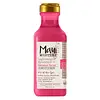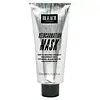What's inside
What's inside
 Key Ingredients
Key Ingredients

 Benefits
Benefits

 Concerns
Concerns

 Ingredients Side-by-side
Ingredients Side-by-side

Aloe Barbadensis Leaf
MaskingWater
Skin ConditioningBehentrimonium Chloride
PreservativeCetearyl Alcohol
EmollientCetyl Alcohol
EmollientGlycerin
HumectantPPG-3 Benzyl Ether Myristate
EmollientSteareth-20
CleansingCocos Nucifera Water
MaskingHibiscus Abelmoschus Flower/Seed Water
MaskingPassiflora Incarnata Fruit Extract
Skin ConditioningCitrus Medica Vulgaris Fruit Extract
AntioxidantUndecane
EmollientPolyquaternium-47
Skin ConditioningTridecane
PerfumingPolyquaternium-37
Glycol Distearate
EmollientPropylene Glycol Dicaprylate/Dicaprate
EmollientPPG-1 Trideceth-6
Skin ConditioningIsopropyl Alcohol
SolventMaltodextrin
AbsorbentCitric Acid
BufferingSodium Hydroxide
BufferingSodium Benzoate
MaskingParfum
MaskingAloe Barbadensis Leaf, Water, Behentrimonium Chloride, Cetearyl Alcohol, Cetyl Alcohol, Glycerin, PPG-3 Benzyl Ether Myristate, Steareth-20, Cocos Nucifera Water, Hibiscus Abelmoschus Flower/Seed Water, Passiflora Incarnata Fruit Extract, Citrus Medica Vulgaris Fruit Extract, Undecane, Polyquaternium-47, Tridecane, Polyquaternium-37, Glycol Distearate, Propylene Glycol Dicaprylate/Dicaprate, PPG-1 Trideceth-6, Isopropyl Alcohol, Maltodextrin, Citric Acid, Sodium Hydroxide, Sodium Benzoate, Parfum
Water
Skin ConditioningCetearyl Alcohol
EmollientBehentrimonium Chloride
PreservativeGlycerin
HumectantOctyldodecanol
EmollientCetrimonium Chloride
AntimicrobialAmodimethicone
Isopropyl Alcohol
SolventSodium Benzoate
MaskingLactic Acid
BufferingDipropylene Glycol
HumectantParfum
MaskingHydrolyzed Wheat Protein
Skin ConditioningHydrolyzed Vegetable Protein Pg-Propyl Silanetriol
Skin ConditioningLauryl Pyrrolidone
CleansingTrideceth-12
EmulsifyingPropylene Glycol
HumectantPhenoxyethanol
PreservativePolyamide-2
Benzoic Acid
MaskingSaccharomyces/Magnesium Ferment
Helianthus Annuus Seed Extract
Skin ConditioningPotassium Sorbate
PreservativeSaccharomyces/Iron Ferment
Skin ConditioningSaccharomyces/Zinc Ferment
Skin ConditioningSaccharomyces/Copper Ferment
Skin ConditioningSaccharomyces/Silicon Ferment
Skin ConditioningBenzyl Salicylate
PerfumingCoumarin
PerfumingLinalool
PerfumingWater, Cetearyl Alcohol, Behentrimonium Chloride, Glycerin, Octyldodecanol, Cetrimonium Chloride, Amodimethicone, Isopropyl Alcohol, Sodium Benzoate, Lactic Acid, Dipropylene Glycol, Parfum, Hydrolyzed Wheat Protein, Hydrolyzed Vegetable Protein Pg-Propyl Silanetriol, Lauryl Pyrrolidone, Trideceth-12, Propylene Glycol, Phenoxyethanol, Polyamide-2, Benzoic Acid, Saccharomyces/Magnesium Ferment, Helianthus Annuus Seed Extract, Potassium Sorbate, Saccharomyces/Iron Ferment, Saccharomyces/Zinc Ferment, Saccharomyces/Copper Ferment, Saccharomyces/Silicon Ferment, Benzyl Salicylate, Coumarin, Linalool
Ingredients Explained
These ingredients are found in both products.
Ingredients higher up in an ingredient list are typically present in a larger amount.
This ingredient is a preservative and often used for it's anti-static properties. You'll most likely see this ingredient in hair conditioners.
It does not cause irritation or sensitization in leave-on products at 1-5%.
Cetearyl alcohol is a mixture of two fatty alcohols: cetyl alcohol and stearyl alcohol. It is mainly used as an emulsifier. Emulsifiers help prevent the separation of oils and products. Due to its composition, it can also be used to thicken a product or help create foam.
Cetearyl alcohol is an emollient. Emollients help soothe and hydrate the skin by trapping moisture.
Studies show Cetearyl alcohol is non-toxic and non-irritating. The FDA allows products labeled "alcohol-free" to have fatty alcohols.
This ingredient is usually derived from plant oils such as palm, vegetable, or coconut oils. There is debate on whether this ingredient will cause acne.
Due to the fatty acid base, this ingredient may not be Malassezia folliculitis safe.
Learn more about Cetearyl AlcoholGlycerin is already naturally found in your skin. It helps moisturize and protect your skin.
A study from 2016 found glycerin to be more effective as a humectant than AHAs and hyaluronic acid.
As a humectant, it helps the skin stay hydrated by pulling moisture to your skin. The low molecular weight of glycerin allows it to pull moisture into the deeper layers of your skin.
Hydrated skin improves your skin barrier; Your skin barrier helps protect against irritants and bacteria.
Glycerin has also been found to have antimicrobial and antiviral properties. Due to these properties, glycerin is often used in wound and burn treatments.
In cosmetics, glycerin is usually derived from plants such as soybean or palm. However, it can also be sourced from animals, such as tallow or animal fat.
This ingredient is organic, colorless, odorless, and non-toxic.
Glycerin is the name for this ingredient in American English. British English uses Glycerol/Glycerine.
Learn more about GlycerinIsopropyl Alcohol is more commonly known as rubbing alcohol. It is most commonly used as a solvent, meaning it helps other ingredients dissolve.
This ingredient is an astringent alcohol. Astringent alcohols may also irritate skin as they high amounts may strip away your skin's natural oils.
Other types of astringent alcohols include:
According to the National Rosacea Society based in the US, you should be mindful of products with these alcohols in the top half of ingredients.
Any type of sanitizing product will have high amounts of alcohol to help kill bacteria and viruses.
Learn more about Isopropyl AlcoholParfum is a catch-all term for an ingredient or more that is used to give a scent to products.
Also called "fragrance", this ingredient can be a blend of hundreds of chemicals or plant oils. This means every product with "fragrance" or "parfum" in the ingredients list is a different mixture.
For instance, Habanolide is a proprietary trade name for a specific aroma chemical. When used as a fragrance ingredient in cosmetics, most aroma chemicals fall under the broad labeling category of “FRAGRANCE” or “PARFUM” according to EU and US regulations.
The term 'parfum' or 'fragrance' is not regulated in many countries. In many cases, it is up to the brand to define this term.
For instance, many brands choose to label themselves as "fragrance-free" because they are not using synthetic fragrances. However, their products may still contain ingredients such as essential oils that are considered a fragrance by INCI standards.
One example is Calendula flower extract. Calendula is an essential oil that still imparts a scent or 'fragrance'.
Depending on the blend, the ingredients in the mixture can cause allergies and sensitivities on the skin. Some ingredients that are known EU allergens include linalool and citronellol.
Parfum can also be used to mask or cover an unpleasant scent.
The bottom line is: not all fragrances/parfum/ingredients are created equally. If you are worried about fragrances, we recommend taking a closer look at an ingredient. And of course, we always recommend speaking with a professional.
Learn more about ParfumSodium Benzoate is a preservative. It's used in both cosmetic and food products to inhibit the growth of mold and bacteria. It is typically produced synthetically.
Both the US FDA and EU Health Committee have approved the use of sodium benzoate. In the US, levels of 0.1% (of the total product) are allowed.
Sodium benzoate works as a preservative by inhibiting the growth of bacteria inside of cells. It prevents the cell from fermenting a type of sugar using an enzyme called phosphofructokinase.
It is the salt of benzoic acid. Foods containing sodium benzoate include soda, salad dressings, condiments, fruit juices, wines, and snack foods.
Studies for using ascorbic acid and sodium benzoate in cosmetics are lacking, especially in skincare routines with multiple steps.
We always recommend speaking with a professional, such as a dermatologist, if you have any concerns.
Learn more about Sodium BenzoateWater. It's the most common cosmetic ingredient of all. You'll usually see it at the top of ingredient lists, meaning that it makes up the largest part of the product.
So why is it so popular? Water most often acts as a solvent - this means that it helps dissolve other ingredients into the formulation.
You'll also recognize water as that liquid we all need to stay alive. If you see this, drink a glass of water. Stay hydrated!
Learn more about Water